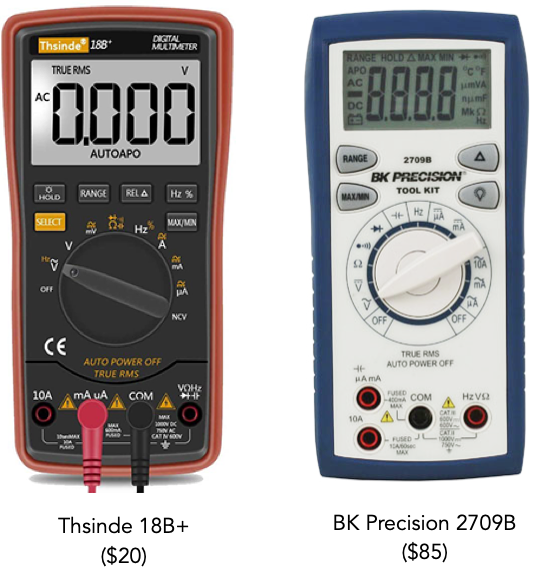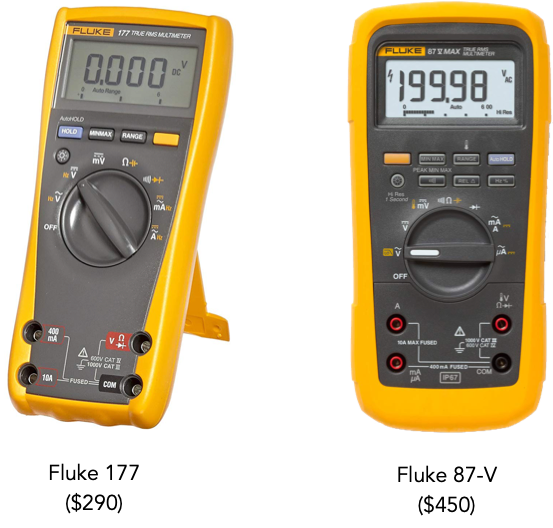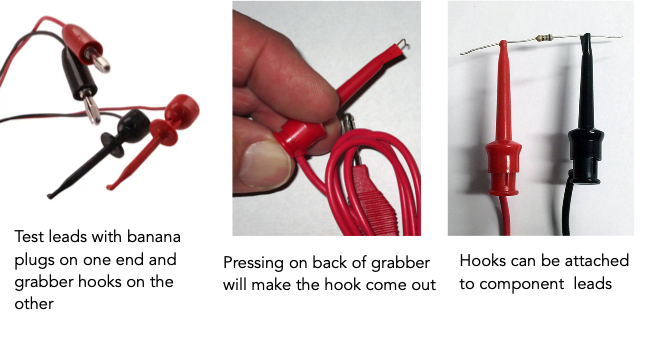EE109 – Spring 2023: Introduction to Embedded Systems
Digital Multimeters
When EE109 students do not have access to VHE 205 and must do some or all of the labs remotely, all students are required to have access to a digital multimeter (DMM) of some type. These are normally provided for student use in the VHE 205 classroom, but if access is not allowed then students have to purchase their own meter. This web page describes what a DMM is, what it does and provides advice on how to shop for one that will meet the needs of the class. This information is provided here since it may be of use to students who need to purchase their own DMM.
What is it?
A digital multimeter is a combination of several instruments, all designed to measure a specific electrical quantity. At a minimum it is combination of the following devices.
- Voltmeter - Used to measure AC and DC voltages in volts
- Ammeter - Used measure AC and DC current in amperes
- Ohmmeter - Used to measure electrical resistance in ohms
Instruments of this type have been around for many years and were also called a VOM for "Volt-Ohm Meter". At first these were analog meters with a mechanical needle that moved to indicated the measurement, but by the 1970's the displays had become digital and hence they became known as digital multimeters. In the VHE 205 classroom these are provided as benchtop DMM's that are designed to sit on a workbench and be plugged into a wall outlet for power. However DMM's are also available in a portable form that perform most of the same functions and are sufficient for the needs of students taking EE109. For personal use we recommend that students purchase a handheld, battery-powered DMM mainly because they are cheaper and also simpler to use.

What does it do?
As mentioned above a DMM is designed to make a number of different electrical measurements. When buying one it's important to find one that can make the necessary measurements, and do it to the required accuracy. DMMs are used in a wide variety of applications, and many are designed for to provide the features needed for that specific application. As a result they may not be the best instrument for other uses.
Displayed results
Most DMM's use some sort of digital display but the number of digits can vary. The bench DMM shown above has a "5 1/2 digit" display, meaning there are five full digits shown to the right, and then the left most digit is either a one or not shown at all. If a voltage is being displayed as 1.99999 volts with five decimal places, and then gets a bit higher, the display then shows 2.0000 with just four decimal places.
The more digits provided implies the DMM is capable of making more accurate measurements, and accuracy cost money. For this class you will not need a DMM with more than a 3 1/2 digit display.
Voltage
A DMM must be able to measure both DC (direct current) and AC (alternating current) voltages, and all pretty much do that. At the high end most DMMs should be able to measure up to 1000 volts, although we won't be using voltages anywhere near that high in EE109! The more important number is the resolution of the voltages when measuring smaller voltages. The DMM should have a resolution of 0.1mV (millivolts). For example, this means it can show the difference between a 12.4 and 12.5 millivolt signal. If the resolution was just 1mv, it would say 12mv for both signals.
Current
The DMM must be able to measure both AC and DC electrical current. Current is measured in amperes and most DMMs measure up to 10 amperes (10A) of current. Again this limit is far beyond anything we will do in EE109. As with voltages, the more important number is the resolution for measuring much smaller currents. A resolution of 0.1μa (microamp) is recommended.
Resistance
Resistance is measured in ohms, indicated as "Ω", and all DMMs are capable of making these measurements. Typically the maximum resistance is around 50 megohm (50MΩ) and the resolution for small resistance is 0.1Ω
Other measurements
The measurements listed above, voltage, current and resistance are the "Big Three" of DMM capabilities. Depending on the DMM it my be able to make several other types of measurements which can be useful in certain applications.
- Continuity - This is simply a measurement of whether there is a complete circuit from one point to another. It can easily be done by measuring the resistance, zero resistance means a complete circuit, infinite meaning not complete or an "open circuit". A DMM that has continuity capability just adds an audio indication of a complete circuit or not, and this can be very handy and make testing circuits much easier to do. You can test for continuity in a circuit by moving the probes to each end and not have to be constantly looking at the display. If you hear a beep from the DMM, there is continuity, no beep means the circuit is open.
- Capacitance - Capacitors are one of the fundamental electronic components used in circuits. This feature allows the DMM to measure the value of capacitors in the same way it can measure resistance of resistors and show the capacitance value. Capacitance is measured in farads (F), but the vast majority of capacitors have values in microfarads (μF), nanofarads (nF) or picofarads (pF). A resolution of 1pF is recommended.
- Frequency - With the capability the meter can measure the frequency of AC signals and show the results in Hertz (Hz).
- Diode test - This allows the meter to test diodes that allow current to only pass in one direction. It will show the forward voltage drop across the diode. It's similar to a continuity test but due to the nature of how a diode works this mode provides more information about how the diode is working.
Which one should I buy?
When selecting a DMM make sure it has the features that will be required as discussed above. Before purchasing one we recommend downloading the manufacturers specifications or manual and checking that it does what you will need.
DMMs come in wide range of capabilities and prices. For most of what we do in EE109 the cheaper DMMs will work just as well as the more expensive ones, but the more expensive ones do tend to be better built and more reliable. Below we discuss some typical models at different price points, but there are many others on the market at similar prices and students are not obligated to buy one of the models shown below.
Low end
You can buy a pretty decent DMM for around $20 that should do everything required in the EE109 labs. Just make sure that it has the required resolution on the various measurements.
One model is the Thsinde 18B+ (shown below) which is available online from Amazon and others. It seems to work fine for making measurements. The only issue we have encountered is that the red and black probes that come with it don't plug into the DMM as securely as we would like and this sometimes requires wiggling the connector to make it work properly. Since we also strongly recommend buying the additional test leads that are described below, and these fit fine, this isn't a major issue.
Middle ground
A meter that has had positive reviews from some EE web sites is the BK Precision 2709B which sells for around $85. I've used BK Precision test equipment several times over the years and they have been solid performers considering they are reasonably priced.

High end
If you want to spend significantly more money consider one of these two meters. The Fluke 177 is a very good meter, and at $290 it better be. Many EE's in online forums swear by it. Fluke has been around for many years and the 177 is one of their products that is built in the USA. I bought a Fluke meter in 1979, and it's still works fine and is my go-to meter that I use regularly.

If you want go to the top end of Fluke's line, there is the model 87-V for around $450. It has a 4 1/2 digit display but aside from that I don't see much reason to buy an 87-V over the 177 for use in EE109, but there are a lot of EE's in online forums who have bought them and think highly of them.
Useful additions
When you purchase a DMM it normally comes with a set of test leads with a connector at one end and a "probe" and the other end. The test lead usually has about a three foot wire and one end goes in the red or black connector on the DMM, and at the other end the probe has a metal pin sticking out that you use to poke around inside the circuit and touch places where you want to make a voltage measurement.
This works fine in many situations but not always. The problem with using a probe like this is that you have to hold it against the place you are trying to measure, and this can be difficult when building circuits on the type of wiring breadboards we use in EE109. When the labs are taught in the VHE 205 classroom, we have a supply of test leads that have little grabber hooks at one end in place of where the probe would be, and students can use these with the benchtop DMMs to make measurements.

These test leads with the grabber hooks are a very useful accessory to have and we recommend purchasing a pair of test leads with these grabber hooks to use with your DMM. Below are a some links to vendors that sell these.
You can buy them from any place but make sure they have a "banana" plug on one end so it will be compatible with your DMM.